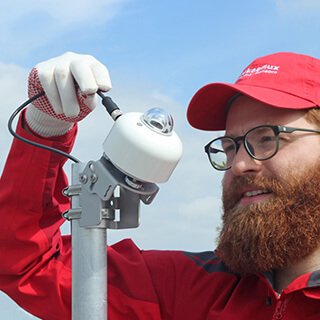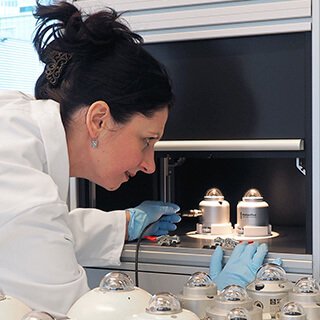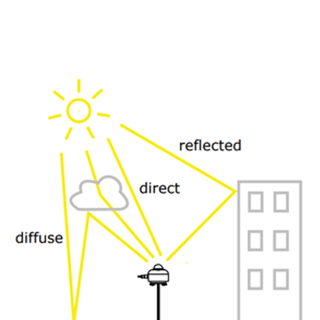How to get the best solar irradiance measurements?
How to get the best solar irradiance measurements? It all starts with choosing the right radiation sensor. However, there are external factors that impact the measurement. For example, dew or frost on the dome and offsets may affect the data. In this article, we give tips on how you can, by choosing the right instrument type, reduce or even prevent such effects to get the best results.
Pyranometer introduction
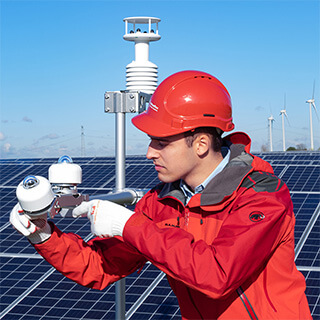
PV system monitoring.
A pyranometer is a solar radiation sensor that measures global irradiance. This radiation originates from the sun and can be reflected by clouds, buildings, trees, etc. The pyranometer absorbs solar radiation through a black-coated sensor. This thermal sensor converts the radiation into heat, which is measured using a thermopile.
Pyranometers have many different applications. They are mostly used for monitoring PV systems. In meteorology, pyranometers are used for weather monitoring, or climate monitoring in long-term applications.
Choosing the right radiation sensor
The first step in achieving a good measurement is choosing the right sensor. Before selecting the appropriate sensor, there are several factors to take into account. These include the application, the specific standards that need to be met, the required level of accuracy, and the potential for maintenance and cleaning.
Higher-accuracy sensors will need more maintenance to reliably attain their potential accuracy. The accuracy level can be divided into three categories according to ISO 9060:2018 classification; Class A, B, and C. Class A has twice the accuracy level of Class B and similarly, the accuracy of Class B increases by a factor two compared to C. This is clearly visible in Figure 2.
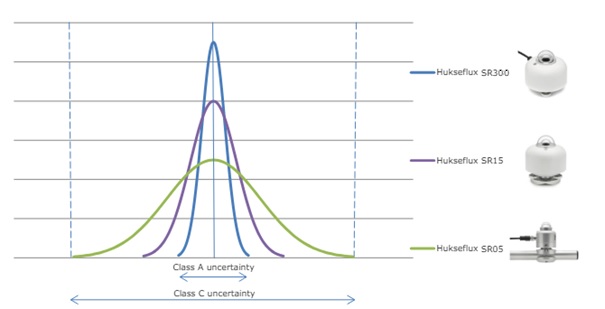
The blue graph is Class A, the purple graph is Class B,
and the green graph is Class C.
Possible errors
It is easy to make errors during a solar radiation measurement. The hardest part is detecting them, in order to flag them as unreliable, reduce or even prevent them.
There is a general procedure to identify possible measurement errors, developed by the Baseline Surface Radiation Network (BSRN). The BSRN distinguishes three cases.
The first error occurs when the measurement falls below or exceeds possible limits. The second is when it falls below or exceeds extremely rare limits. Third, when the measurement is too high or low compared to similar measurements an error also occurs. The BSRN recommends excluding all the physically impossible data. For the other two cases, the user has to decide whether to include the result after careful analysis.
Following are a few of the most common errors and different ways to detect each of them.
Dew and frost
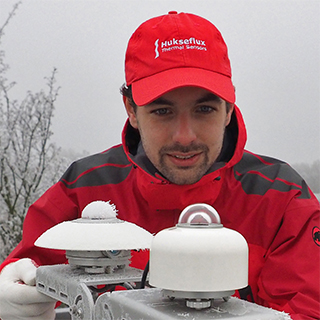
pyranometer, while the pyranometer on the right,
heated just above frost point, is kept clear.
Dew forms when the temperature of the instrument body drops below the dew point. This happens mostly on clear nights. The colder surface of the instrument cools the surrounding air. When the humidity is high enough, water droplets will form on the dome. This results in dew. It can cause errors in the measurement for the first few hours after sunrise when the temperature is still below the dew point. Dew may remain on the dome for some time after the sun has risen above the horizon. It can cause lensing, which may lead to both over- and underestimation of the irradiance.
Frost is slightly different than dew. It can form throughout the entire day, but is most common in the morning. Instead of water droplets, ice crystals form on the dome, see Figure 3. This happens when the temperature drops below the frost temperature, which is always below 0 °C. Frost may act as a diffusor, which diffracts the light.
Detecting frost and dew with 100 % certainty is only possible when inspecting the pyranometer visually, but there are a few ways to detect it from data. The BSRN check described above cannot be used in this case. The difference in irradiance is too small, so we have to use other procedures.
The risk of dew occurs when the instrument temperature falls below the dew point. This instrument temperature measurement is possible with most pyranometers. Many pyranometers have body temperature sensors on board. Also, many stations contain ambient air temperature and humidity sensors.
Detection of the risk of frost, on the other hand, is more difficult. There is no practical solution as most humidity sensors stop working below 0 ° C.
However, there are also typical fingerprints that become noticeable when looking at a solar irradiance graph. In Figure 4, the effect of a dew event becomes clear. The dew droplets cause lensing from 8:00 hours, which results in an overestimation of the solar irradiance. Around 8:45 hours, they dim the incoming radiation. Cloud lensing causes the deviation after 10:00 hours.

instruments and modelling of clear sky irradiance. From 10:00, the deviation is caused by clouds.
For frost, there is only lensing due to the ice crystals present. This results in a slight overestimation of the solar irradiance. Figure 5 displays this event.
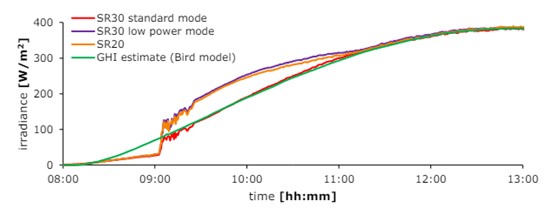
Offsets
Offsets (also called zero-offsets) occur when the signal is different from zero, but there is no solar radiation present. Offsets are often so small that they can be ignored in most cases. But under certain low-light conditions, they make a significant contribution. These offsets happen when there is a temperature difference between the sensor body and the black thermal sensor, that did not originate from solar radiation.
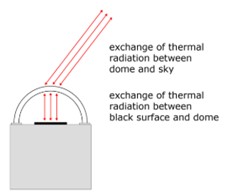
the thermal radiation offset. There is an
exchange of heat between the different components.
There are three common types of offsets.
- The first one is thermal longwave infra-red radiation, which can happen when radiation other than solar is exchanged between the atmosphere and dome, or between the dome and black sensor. This type of offset is demonstrated in Figure 6.
- The second type of offset occurs when the ambient temperature changes suddenly. This can happen at sunrise and sunset, or when a warm or cold wind suddenly picks up.
- The last type of offset is due to the electronics or heating. They generate heat that can influence the measurement. However, these contribute the least amount of offset.
Other error sources
Many other things can influence your measurement. Dirt and dust can accumulate on the sensor. This is easily removable by blowing it away or gently wiping it away to prevent scratches. Moreover, shadows of surrounding structures can also be a problem. This can be detected by looking at the data from multiple consecutive days or months.
Solutions for solar irradiance measurement errors
For most of the errors mentioned above, there is a solution to prevent or reduce them. In the following paragraph, we explain each of these options to improve your solar irradiance measurement.
Heating and ventilation
There are two types of heating: internal and external. They both aim for a thermal equilibrium inside the sensor and between the sensor and the cold blue sky to reduce offsets. This results in high data availability with the best accuracy. Pyranometers like the Hukseflux SR300-D1 and SR30-M2-D1 have integrated internal heating. But using only heating, without ventilation can lead to other problems, so ventilation is also important. Therefore, the SR300-D1 and SR30-M2-D1 have both heating and ventilation. For other pyranometer models, the VU01 ventilation unit adds external ventilation. More on this later in this article.
Regular maintenance
Like most sensors, pyranometers also need maintenance. First of all, they need regular cleaning of their domes. For Class A pyranometers, ISO recommends weekly cleaning. For Class B, this is only necessary once every two weeks. Besides regular cleaning, we recommend a more thorough visual inspection every six months. This way, you will also notice possible scratches on the dome, which can lead to less accurate data.
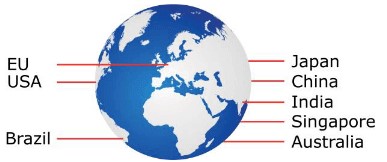
Calibration
Pyranometers have to be calibrated every two years according to ISO, IEC and WMO standards. The cost of recalibration can be high when you have to ship your sensor to the calibration facility. Hukseflux helps you reduce these costs by having facilities around the world.
Two domes
When using two domes, like with the SR300-D1 and SR30-M2-D1, thermal radiation offsets are reduced. The second dome helps prevent longwave infrared radiation from reaching the black sensor, which otherwise would cool it down. So it acts as insulation, in optical terms a “radiation screen”. More information can be found in the article: Solar radiation sensors: become a pyranometer expert.
Other offsets
The offset caused by a rapid change in ambient temperature can be measured in a temperature-controlled chamber. You can measure the offset while changing the temperature, at a constant rate of change in K/hr, of the chamber in a dark condition.
Offsets due to heating of electronics cannot be prevented, but it is important to keep those in mind. They are small, but can be significant for high-accuracy measurements.
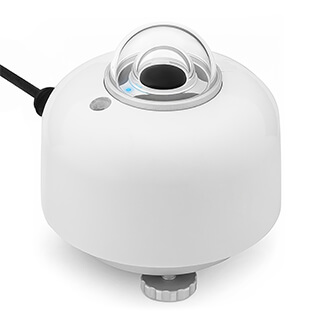
The SR300-D1 pyranometer
One of our newest solar radiation sensors is the SR300-D1 pyranometer, which can be seen in Figure 8. It is spectrally flat and ISO Class A compliant without the need for additional accessories. Designed to be industrial-grade, it offers even higher data availability than previous models. It is the ideal instrument for PV monitoring systems and meteorological stations. So, in case you need the most accurate solar radiation measurement, we recommend to select the SR300-D1 pyranometer.
Compared to other pyranometer models that we offer, the SR300-D1 has a lot of advantages. The most important one is the superior surge protection. The pyranometer is immune to high voltages and currents, making it suitable for industrial environments like PV power plants. By adding the external Surge Protection Device SPD01, the immunity can increase up to 4 kV. The SR300-D1 is also equipped with a earthing terminal for a connection with protective earth.
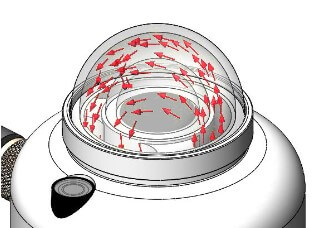
Heating (RVH™) technology.
Another advantage is the Recirculating Ventilation and Heating technology (RHV™). Instead of heating the sensor dome on the outside, the heated air is kept inside, as seen in Figure 9. It results in a more uniform temperature, reducing the thermal radiation offsets. Because the air is contained, it retains heat more effectively and requires less energy to stay warm. Even less power can be used because there are three power modes.
Besides heating and ventilation, it is possible to turn both off, or turn only the heating off, depending on the required accuracy. The efficient RHV™ technology results in frost and dew mitigation in all climates, with a smaller environmental footprint. Even in cold climates, the SR300-D1 delivers high-accuracy results.
Another advantage is remote diagnostics. They reduce the need for field inspections and make maintenance easier. Via the remote diagnostics, alerts can be given for: high internal humidity, instrument leakage, change of tilt or rotation, and a heating and ventilation malfunction. Even with remote diagnostics, regular visual inspections are necessary to remove dust, dirt, or stains from evaporated dew water droplets.
VU01 ventilation unit
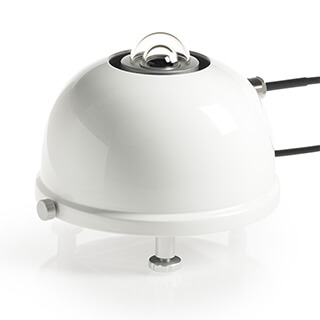
External heating is achieved when using an external ventilation system such as the VU01. The ventilation unit can be added to pyranometers and pyrgeometers for higher data availability. It keeps the dome above the dew point to prevent dew and frost deposition. However, it does require more power than the RVH™ technology. When using high-power heating, it can also introduce higher than usual thermal zero-offsets. That is why heating is only recommended when necessary.
Another disadvantage of ventilation is regular maintenance of the ventilator and air filters. However, the ventilators are designed in such a way that they only work well when their filters are kept clean, so the VU01 requires frequent filter cleaning when used in climates with a lot of dust.
Please mind that small errors may occur when using external heating. Looking at Figure 11, it is clear that external ventilation and heating are not fully effective against dew and frost and still introduce small offsets. The unheated pyranometer shows a clear deviation from the expected cosine curve, which makes it easier to notice and filter out. The externally ventilated and heated pyranometer does not show a clear deviation. So, for solar irradiance measurements where high accuracy is necessary, this is not the best choice.
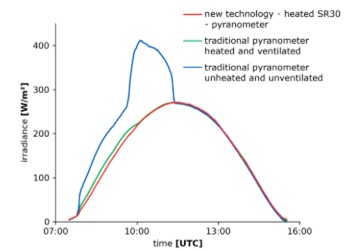
three different pyranometer setups.
Solar monitoring can be tricky, but using these tips can make your measurement more accurate. By choosing the right sensor for your application and local conditions, introducing heating and ventilation, and regular maintenance, many errors can be avoided. If you select a Hukseflux solar radiation sensor, you are ensured of the most accurate measurement results possible.








